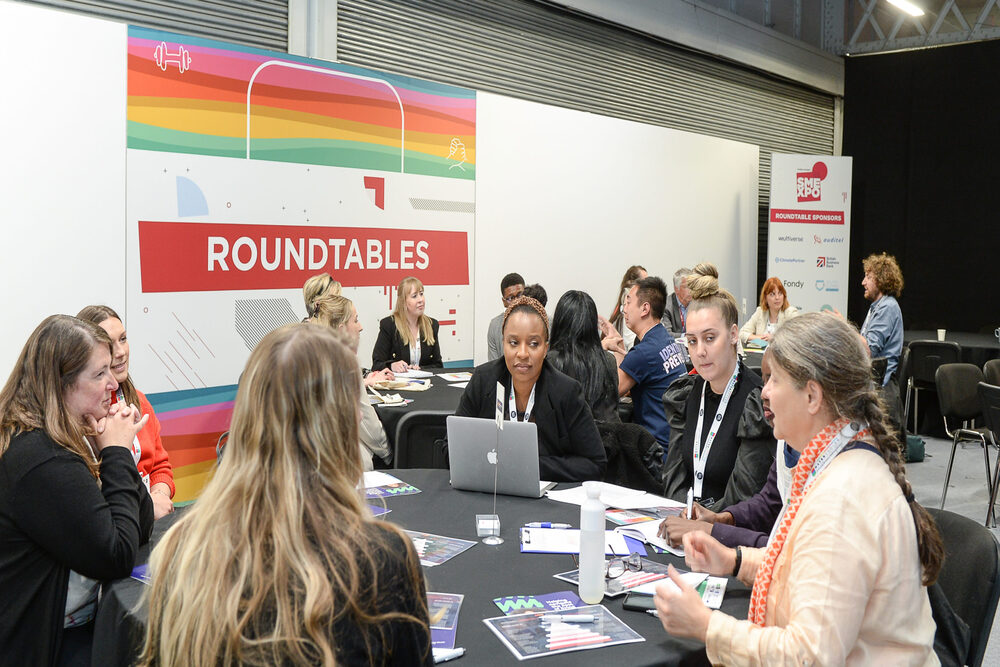Business for Health (B4H) ran a roundtable at The Watercooler event on 26 May, focussed on ‘Workforce Design to Address Health Inequalities – Scoping the Future to Link Health to Wealth.’ This kicked off the inaugural discovery roundtables with our project with Impact on Urban Health that will explore how positive work can make a real difference in people’s health and inform the future of workforce design to enhance health and reduce health disparities.
The changing workforce itself has presented new opportunities for support and job design, including skills-building for lower-wage earners to support professional advancement. Topics of all roundtables will include exploring meaningful work, hybrid work and flexible work with a real focus on lower-income, frontline roles, including precarity, uncertainty and cost of living crisis.
Senior industry leaders from different sectors came together to share how their businesses, or representative bodies, are tackling the wider determinants of health in hard-hit sectors like retail, hospitality, leisure and care. They offered insights on current models of standards and measurement, but that lack health impact as part of them, which could provide an opportunity to put our weight behind as an industry model (ie Better Business Act, B-corp).
We set the scene by talking about how businesses have a role in addressing health inequalities, linking health to wealth and how this translates into productivity and the shared value that we can create with our efforts in levelling up.
We know that addressing social needs through targeted interventions provides invaluable assistance for our workforce. But we also must remain focused on addressing the social determinants, an upstream approach, creating the conditions for how people work, live, and thrive. These systemic changes are needed to address the root causes of ill health. The demand for social needs interventions won’t stop until the true root causes are addressed.
Chris-Brook Carter, CEO from the Retail Trust, says the “biggest challenge we have in getting companies to adopt our services and pay for the membership is creating the clear link that there is a business benefit for doing this. And we have a whole range of products but it’s still at a point where we can’t demonstrate yet clear return on investment, despite knowing they make a huge impact. Companies are not measuring the impact yet because there’s not a clear index.”
He also goes on to say, “the biggest single factor that affects someone’s sense of wellbeing at work, is culture rather than the actual tools that are in there. So what is their relationship with their line manager? Do they feel valued? Do they have the right tools to do the job? Do they feel overstressed? So all those cultural issues that come from leadership within an organisation.”
Kim Chaplain from Centre for Ageing Better says “There is no guidance,” and organisations are confused by which standards to follow. Without clear regulation, it becomes hard to tackle these issues, including keeping the older workforce in the labour market.
Jeanette Nielson, HR Manager at Belzona Polymerics Ltd, extends their health package to all employees and not just senior management. She acknowledged the challenges with extending benefits for SMEs and self-employed companies, but that including families in offerings is a must-do for greater access.
Alex Lucas, Senior Research Analyst at ukactive, says “ So some of the the key findings have come out in terms of individuals and SMEs feeling that they can take the opportunity to be physically active during the working day to look after their wellbeing and that sense, comes from having the permission from the line managers and from their senior staff, and also the role modelling aspect as well.” Their next pilot launching with government aligns with shifting the narrative and cultural perception around engagement and productivity.
Nick Pahl, CEO from Society of Occupational Medicine, says “We need to try and get simplicity from the complexity of a variety of interventions as to what we want to achieve.” His emphasis on quick ROI from musculoskeletal interventions and ergonomics could provide a strong economic return. He recommends the Business Calculator from Evolve Workplace Wellbeing to build the business case and show ROI on programming.
Key takeaways from the round table discussion from cross-sector approaches acknowledges the complexity in addressing these wider determinants:
1. What’s the business’s responsibility before employees get into a crisis? We need to prove the financial benefit to shift the dial on business.
2. Everyone is struggling with recruiting and retaining talent. If we can clearly link how happy and healthy someone feels at work and their propensity, their flight risk (ie turnover), there is a clear case that shifts the dialogue.
3. In the retail sector, line managers lead about 80% of the workforce and also hold about 80% of the customer relationships. They are under invested in the softer skills of leadership around spotting mental health problems. How do they deal with an ever increasing array of situations that are going on within their teams from clinically diagnosed mental health conditions all the way down to anxiety, which have knock-on effects in other areas of health (ie sleep, performance)?
4. There is a clear need for better training as part of career development. But there’s also a clear economic, almost precipice for the industry, that if they don’t fix this, their businesses, structurally, are going to collapse.
5. Which levers do we pull so if someone’s starting off on building a health and wellbeing strategy in their organisation, which are the important aspects to invest in? Which areas of the various parts of strategy are going to have the single largest return on investment and improve the wellbeing of the population?
6. There are no clear standards on measuring and monitoring turnover rates, absenteeism rates, incidence of mental ill health. Organisations are willing to give this data, but lack of standardisation causes enormous challenges in benchmarking and measuring.
7. B Corp is a really interesting model for this debate to follow because it’s essentially created a de facto standard for industry. That business clearly wants to get involved because from an investor point of view and employee point of view, there is a market advantage for having their certificate on their website. This kind of standard is important for health, perhaps there could be an “H-corp” certification. Having something that says this is culturally a great place to work and it gives commercial advantage is ultimately what we’re after.
8. On offering potential solutions, one of ukactive’s policies is that they push for something for ‘work out from work’, which is an expansion of the cycle to work scheme to also include a kind of tapestry on things like gym memberships, which links into the flexible and hybrid working aspect. And while it’s great, it doesn’t necessarily support those individuals who might not be going into an office.
9. It’s a mind shift change and a cultural change of the industry of business community to say, it’s important and it might take years for it to have the whole offering but as Chris Brook-Carter says again “unless there’s a significant mindset shift, then we all will end up in the gaps or doing bits and pieces.”
10. Better Business Act – Do we throw our weight behind the Better Business Act, to lobby for health to be a part of their measurement? So the impact on the environment and the communities we work inwould become a legal responsibility of business.
11. Although we are all aware this is a very complex and multifaceted issue, it must be simplified when engaging organisations in order to garner traction.
Insights from the roundtable will inform potential solutions in the design of future work and sustainable health and wellbeing policies and practices in organisations with front-line and/or lower-wage workers and who are more at risk of multiple long-term conditions.
These insights will also build the evidence base to show how people’s health and wellbeing can be enhanced through inclusive economic development and greater focus on tackling the wider determinants of health.
Other resources linked to the Round Table:
Health Key to Levelling Up: Time to Bring ‘Health’ into ESG
The pandemic has highlighted the systemic issues that drive poor health and health inequalities – and how inextricably linked health is to wealth.
by Tina Woods, CEO of Business for Health
Why workplace cultures that support financial wellbeing will be critical in the months ahead
by Nick Pahl, CEO of SOM
Health of Retail Report: Based on a study of nearly 2,000 retail workers, in-depth interviews with HRDs and a survey of a further 4,500 retail employees by WorkL, the report delivers analysis, trends and next steps that makes for essential reading for anyone involved with wellbeing strategy in retail.












